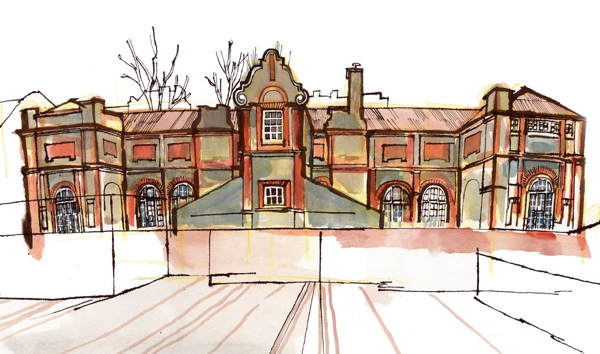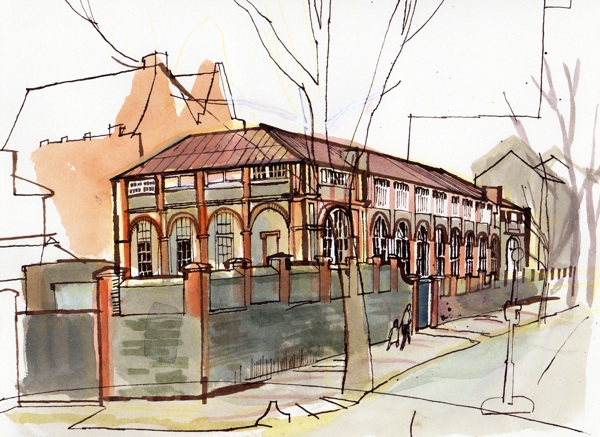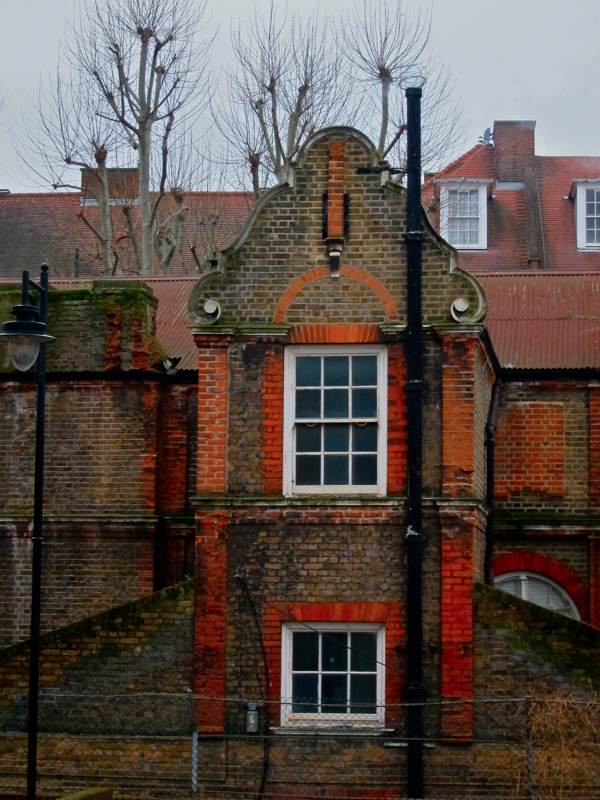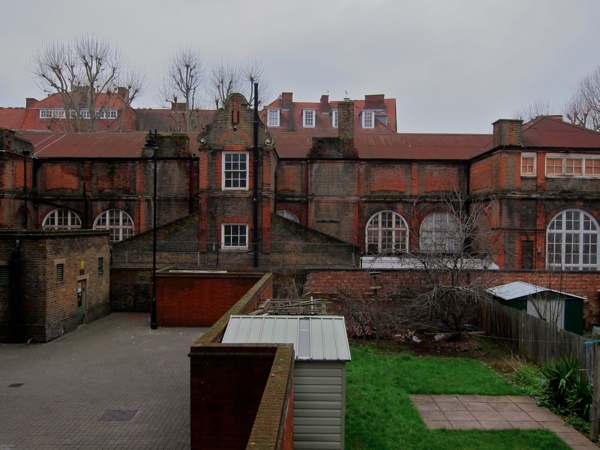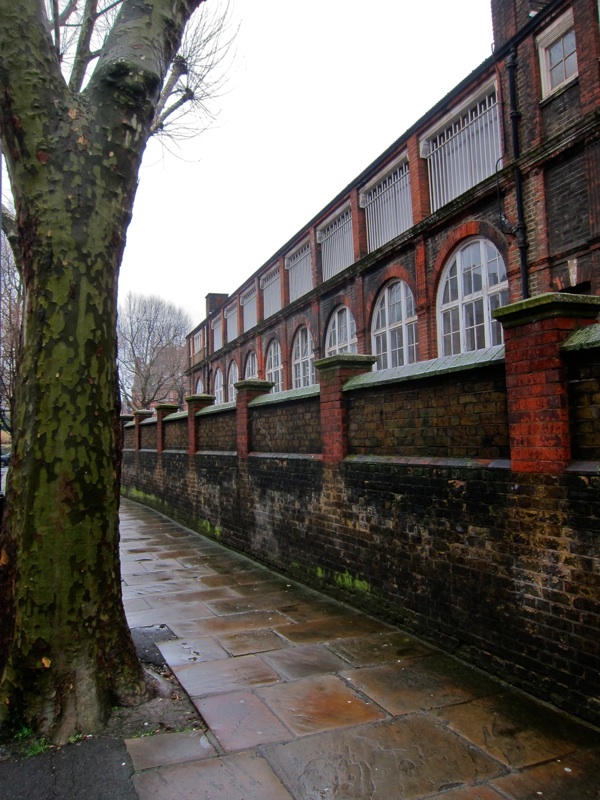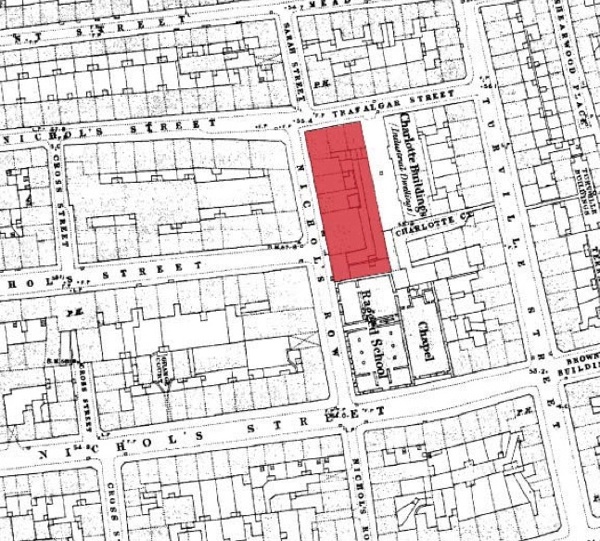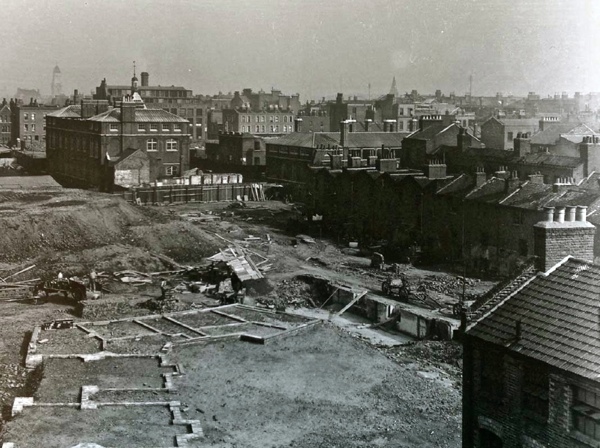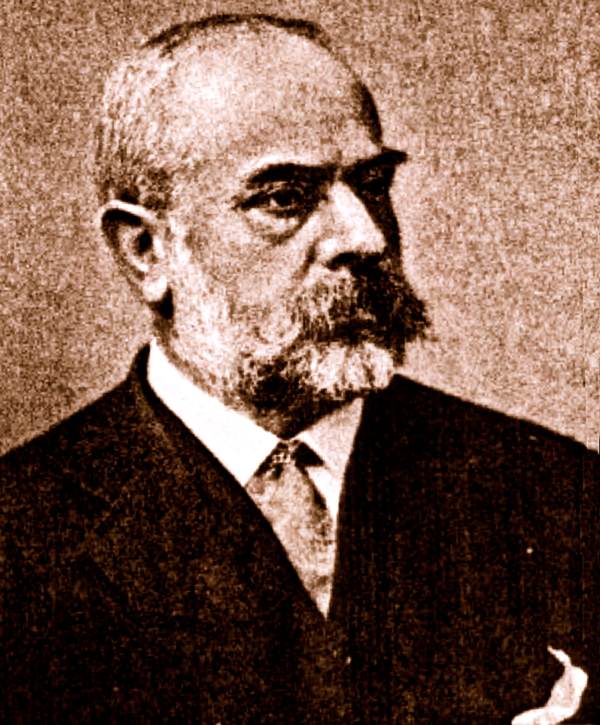On the day that the fate of the Rochelle Infants’ School Building at Arnold Circus on the Boundary Estate will be decided by Tower Hamlets Council, I trace the origins of this modest yet beautiful edifice which tells a unique and important story .
This is Contributing Artist Lucinda Rogers‘ sketch of the front elevation of the former Nichol St Infants’ School that opened in 1879, known as Rochelle Infants’ School since 1900. Yet even those who are familiar with this corner of Shoreditch may not recognise it, because when the surrounding streets were razed in 1895 and the Boundary Estate was constructed around the school as Britain’s first social housing, the orientation of the building changed.
Blending so harmoniously with the Estate buildings on either side, few realise that this school carries the history of those who once lived here in the notorious slum known as the Old Nichol, for whom it was built. Apart from the bandstand created from the pile of the rubble of their demolished homes, the school is now the only visible evidence of their existence. But, unlike the inscrutable mound, through the nature and detail of its design this fascinating building speaks eloquently of life in the Old Nichol.
Walk down Montclare St and enter the yard beside the old Wash House to see this view of the original frontage, conceived upon an eighteenth century model with two symmetrical wings framing an imposing central entrance beneath a gable in the Queen Anne style, which once faced an open space now divided by low walls into gardens and courtyards. The central tower contains two separate staircases – gently sloping for child safety – a shallower one for juniors and a steeper one for senior infants, leading to the covered playground on the roof. Walk around the block to Club Row and you will see the rear elevation, with its row of eight neo-classical arched windows interspersed by brick pilasters, by which the building is most commonly recognised today.
Nichol St Infants’ School was designed by the progressive school architect Edward Robert Robson, who had worked with George Gilbert Scott and knew Dante Gabriel Rossetti personally. In the East End, he was also responsible for the People’s Palace in Mile End and the Jews’ Free School in Spitalfields. Nichol St Infants’ School was constructed as a gesture of idealism to raise the aspirations of the residents of the Old Nichol. In his pioneering and definitive work of 1874, “School Architecture,” Robson wrote, “If popular education be worth its great price, its homes deserve something better than a passing thought. Schoolhouses are henceforth to take rank as public buildings, and should be planned and built in a manner befitting their new dignity.”
Accommodating over three hundred and sixty pupils within the restricted site of Nichol St Infants School required a playground upon the roof, which Robson designed with a metal cover taking into account that pupils might not possess adequate clothing for rain or poor weather. In the classrooms, the high ceilings and large windows were designed to admit plenty of light and air, offering sufficient ventilation to ameliorate the smell of a large number of unwashed infants packed closely together. The architect’s sensitivity to the children’s needs is evident in these considerations and many others, yet his concern extended beyond the material in this modest building, which possesses spare lyrical flourishes that transcend the utilitarian. A prime example is the unexpectedly intricate decorative wooden casing of the iron girders in the ceilings of the classrooms, as if to reward those who lifted their gaze upwards.
Today, the former Nichol St Infants School stands as the only unaltered example of Robson’s principles of school design and thus it is of unique importance, socially, historically and architecturally. Yet this evening Tower Hamlets Council votes on a proposed series of alterations to the building which will change it irreversibly, partly demolishing Robson’s facade to create an extension, raising the roof level, thus destroying the covered playground with its original metal roof structure, and dividing up the double height classrooms with mezzanine floors which will require removing the decorative casings of the beams in the process. Enacting these changes, and more which are proposed, will eradicate much of the meaning of the building – both as a witness of the lives of the people of the Old Nichol, and as a pertinent reminder of an era when improving the lot of the poor, and allowing them human dignity, became a priority.
Sign the petition to protect the Rochelle Infants School Building
Lucinda Rogers’ sketch of the rear elevation of former Nichol St School seen from Club Row.
The original entrance to Nichol St Infants’ School was at the centre of the building, beneath these windows topped by E.R.Robson’s magnificenty flourished gable in the Queen Anne style.
In spite of an accretion of low walls, the symmetrical frontage of Nichol St Infants School is still intact.
The rear of the school seen from Club Row, formerly Nichols Row, showing the windows that give light to the double height classrooms.
Double height classrooms designed by Robson, as employed at Nichol St Infants’ School (From School Architecture 1874)
In 1880, Nichol St Infants School surrounded by the streets of the Old Nichol before they were replaced by the Boundary Estate. (Edina Historical Maps)
1895, the construction of the Boundary Esate around the Rochelle School, seen at the centre of this photograph. The pile of rubble to the left became the bandstand at the centre of Arnold Circus. (City of London, London Metropolitan Archives)
This 1938 London County Council map shows the Boundary Estate as it remains today with the Rochelle Infants’ School Building half way up Club Row on the right.
Edward Robert Robson (1835-1917), Consulting Architect to Her Majesty’s Education Department.
Drawings copyright © Lucinda Rogers
Tower Hamlets Development Committee meet to decide on the application to alter the Rochelle Infants School Building at 7pm today, Wednesday February 13th, Tower Hamlets Town Hall, Mulberry Place, 5 Clove Crescent, London, E14 2BG
UPDATE: 20:26pm 13/02/2013 The council voted to reject the plans and saved the building. Thanks to all who signed the petition.
My grateful thanks to Tom Ridge who supplied his research as the basis of this feature.
You may like to read about some people who were educated at Rochelle School
